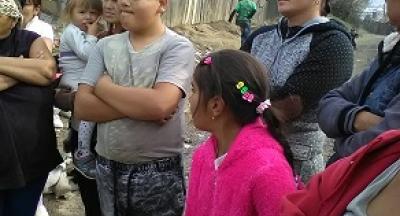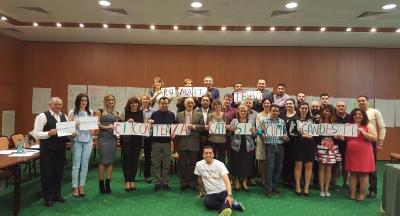Sighisoara
*Disclaimer: The information and views set out in this page do not necessarily reflect the official opinion of the Council of Europe and/or the European Commission. Neither the Council of Europe, the European Commission nor any person acting on their behalf may be held responsible for the use which may be made of the information contained therein.
Last update 16/08/2016
Sighișoara is located in Mureș County, and is listed as a UNESCO World Heritage Site as one of the best preserved medieval cities of Europe. It is also the administrative centre for seven villages: Angofa, Aurel Vlaicu, Hetiur, Rora, Șoromiclea, Venchi and Viilor. Romanians represent the majority of the population (76%), followed by Hungarians and Roma (5.6%) and finally by Germans.
Roma's presence in the city has been documented since before 1900s, a time when they began to organize in guilds of craftsmen (bricklayers, florists, musicians). After the fall of communism in 1989-1990 the situation of the Roma community worsened and this is also the time when Roma became more visible in the community. At the moment, from an infrastructural point of view, the Roma Community from Sighișoara are connected to electricity, and 50% of the dwellings have access to methane gas. Access to sewerage and water supply remain a major issue, as most of the dwellings do not have access to these important services under 500m of walking distance. In addition to these challenge, housing entitlements are at issue with around 80% of the houses were built without legal forms. The existing houses are in relatively habitable condition, but there remains the major problem of poor water quality which can have negative health impacts on the community. With regard to access to healthcare, 80% of the Roma in the municipality are covered by health insurance, see a general practitioner regularly, and live within a 2km distance of a hospital. There is one health mediator working within the Roma community. Education remains a challenge with one of the most urgent issues being the high dropout rate among Roma children after primary school completion with a dropout rate of around 305. This lack of educational achievement is reportedly due to the lack of financial means for families to afford to send their children to school. One of the particular financial challenges to education is the lack of ways to transport children to school. Roma from Sighișoara find job opportunities mostly in construction and agricultural work. There is an unemployment rate in the community that can be as high at 20%. It is estimated that around 60% of the Roma population rely on social welfare for basic subsistence.
The ROMACT Process
With the Mayor’s signature on the Letter of Commitment on the 2nd November 2015, Sighișoara joined the ROMACT programme. Shortly after this the Community Action Group (CAG) was created, became active and prioritized the needs of the community. The tables below summarise some of the most important short-term and long-term needs of the community.
| Short-term priorities of the CAG | Objective 1 | Objective 2 | Objective 3 | Objective 4 | Objective 5 |
|---|---|---|---|---|---|
| Education | Reduce the school dropout rates; | Support adults in advancing their education; Training programmes for adults; | Free transportation for Roma children to school; | Lifelong learning programmes and in particular the development of physical and mental health, sexual and reproductive education | |
| Infrastructure | Renovation of the schools where Roma children learn; | Paving streets in Roma inhabited areas; | Renovation of the 1.5 km of the water network from the Roma community; | Building a playground for the children in the community; | Building of a bridge; |
| Housing | Deratization / Sanitation and cleaning of the houses | Solving the issue of property documents / legalisation of dwellings; |
| Long-term priorities of the CAG | Objective 1 | Objective 2 | Objective 3 |
|---|---|---|---|
| Employment | Finding job opportunities for Roma parents; | Organise qualification courses; | Ensure mediation in the labor market; |
| Infrastructure | Establishing a Day Care Center; |
Based on these newly defined needs, the CAG met with local authorities and their recommendations were included in two measures concerning free school transport for Roma children and the allocation of 3000 sq. metres of land for the building of a Day Care Centre for Roma families. Other measures will be reviewed and included at future City Council meetings.
The Municipality has also expressed an interest in applying for Structural Funds through the Human Capital Operational Programme, Priority Axis 4 - Social inclusion and combating poverty in marginalized Roma communities and Priority Axis 5 - Community Led Local Development (CLLD).
Although the City of Sighișoara does not employ a civil servant dedicated to the design and management of EU-funded projects, together with the CAG and the ROMACT representatives they have managed to train their team on the use of tools and mechanisms for the Human Capital Operational Program (POCU), which resulted in the drafting of applications for Axis 4.1 of the program.
As of August 2016, the following measures were either in progress or completed by the municipality of Sighisoara:
| Priorities | Measure implemented | Measure implemented | Measure implemented | Measure implemented | Measure implemented |
|---|---|---|---|---|---|
| Infrastructure | Rehabilitation of 1.5 km of the water network; | Rehabilitation works of the main roads leading to the Roma community; | Renovation of a bridge; | Renovation of the schools where Roma children learn; | Cleaning the river in the vicinity of the community; |
The municipality staff team working on Roma inclusion in Sighișoara have managed to update and include Roma related plans and actions into every category of the Local Strategy. The CAG and the Local Authorities in Sighișoara are currently working together to improve the general situation of their community by continuously assessing their needs and planning actions to deal with their challenges.
The Municipality benefited of ROMACT expertise for the following projects:
Maintream Sighisoara- european investment for social inclusion, OPHC 4.1
Budget: 2 839 598 euros
Status: approved
Formal and non-formal education for durable development in Centre of area of Romania, OPHC 6.2, 6.3, 6.4, 6.6
Status: rejected


